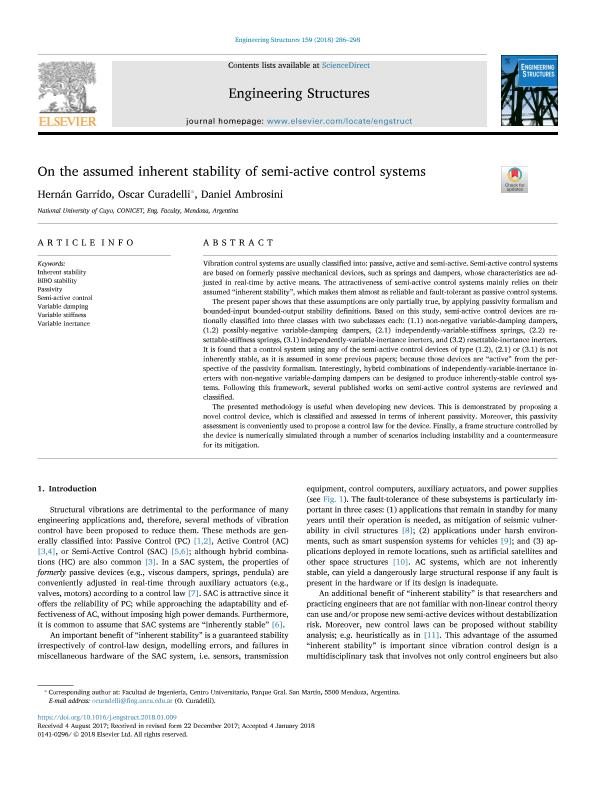Mostrar el registro sencillo del ítem
dc.contributor.author
Garrido, Carlos Hernán

dc.contributor.author
Curadelli, Raul Oscar

dc.contributor.author
Ambrosini, Ricardo Daniel

dc.date.available
2020-01-30T22:14:08Z
dc.date.issued
2018-03
dc.identifier.citation
Garrido, Carlos Hernán; Curadelli, Raul Oscar; Ambrosini, Ricardo Daniel; On the assumed inherent stability of semi-active control systems; Elsevier; Engineering Structures; 159; 3-2018; 286-298
dc.identifier.issn
0141-0296
dc.identifier.uri
http://hdl.handle.net/11336/96334
dc.description.abstract
Vibration control systems are usually classified into: passive, active and semi-active. Semi-active control systems are based on formerly passive mechanical devices, such as springs and dampers, whose characteristics are adjusted in real-time by active means. The attractiveness of semi-active control systems mainly relies on their assumed “inherent stability”, which makes them almost as reliable and fault-tolerant as passive control systems. The present paper shows that these assumptions are only partially true, by applying passivity formalism and bounded-input bounded-output stability definitions. Based on this study, semi-active control devices are rationally classified into three classes with two subclasses each: (1.1) non-negative variable-damping dampers, (1.2) possibly-negative variable-damping dampers, (2.1) independently-variable-stiffness springs, (2.2) resettable-stiffness springs, (3.1) independently-variable-inertance inerters, and (3.2) resettable-inertance inerters. It is found that a control system using any of the semi-active control devices of type (1.2), (2.1) or (3.1) is not inherently stable, as it is assumed in some previous papers; because those devices are “active” from the perspective of the passivity formalism. Interestingly, hybrid combinations of independently-variable-inertance inerters with non-negative variable-damping dampers can be designed to produce inherently-stable control systems. Following this framework, several published works on semi-active control systems are reviewed and classified. The presented methodology is useful when developing new devices. This is demonstrated by proposing a novel control device, which is classified and assessed in terms of inherent passivity. Moreover, this passivity assessment is conveniently used to propose a control law for the device. Finally, a frame structure controlled by the device is numerically simulated through a number of scenarios including instability and a countermeasure for its mitigation.
dc.format
application/pdf
dc.language.iso
eng
dc.publisher
Elsevier

dc.rights
info:eu-repo/semantics/openAccess
dc.rights.uri
https://creativecommons.org/licenses/by-nc-nd/2.5/ar/
dc.subject
BIBO STABILITY
dc.subject
INHERENT STABILITY
dc.subject
PASSIVITY
dc.subject
SEMI-ACTIVE CONTROL
dc.subject
VARIABLE DAMPING
dc.subject
VARIABLE INERTANCE
dc.subject
VARIABLE STIFFNESS
dc.subject.classification
Ingeniería Estructural

dc.subject.classification
Ingeniería Civil

dc.subject.classification
INGENIERÍAS Y TECNOLOGÍAS

dc.title
On the assumed inherent stability of semi-active control systems
dc.type
info:eu-repo/semantics/article
dc.type
info:ar-repo/semantics/artículo
dc.type
info:eu-repo/semantics/publishedVersion
dc.date.updated
2020-01-29T22:34:58Z
dc.journal.volume
159
dc.journal.pagination
286-298
dc.journal.pais
Países Bajos

dc.journal.ciudad
Amsterdam
dc.description.fil
Fil: Garrido, Carlos Hernán. Consejo Nacional de Investigaciones Científicas y Técnicas; Argentina. Universidad Nacional de Cuyo; Argentina
dc.description.fil
Fil: Curadelli, Raul Oscar. Universidad Nacional de Cuyo; Argentina. Consejo Nacional de Investigaciones Científicas y Técnicas; Argentina
dc.description.fil
Fil: Ambrosini, Ricardo Daniel. Universidad Nacional de Cuyo; Argentina. Consejo Nacional de Investigaciones Científicas y Técnicas; Argentina
dc.journal.title
Engineering Structures

dc.relation.alternativeid
info:eu-repo/semantics/altIdentifier/doi/http://dx.doi.org/10.1016/j.engstruct.2018.01.009
dc.relation.alternativeid
info:eu-repo/semantics/altIdentifier/url/https://www.sciencedirect.com/science/article/pii/S0141029617325737
Archivos asociados
